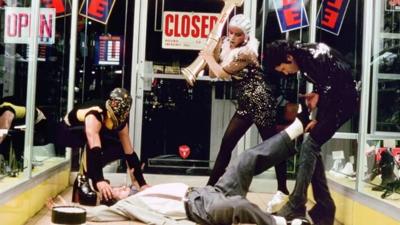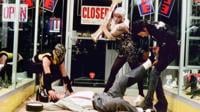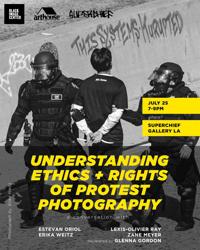It’s a history that’s operatic in scope with elements of beauty, danger, passion and chameleon-like talents, and director Travis Gutiérrez Senger has taken full advantage of these elements in his engrossing documentary, “ASCO: Without Permission”, which recently premiered at Hollywood’s TCL Chinese Theatre as part of the Los Angeles Latino International Film Festival.
The legendary ASCO (Spanish for nausea), was an East Los Angeles based Chicano performance art collaborative who were most active from 1972 to 1987 – a time when the Vietnam War protests and more locally, the East Los Angeles school walkouts had reached their tumultuous zenith. It was, in many respects, an occupied territory – and policed as such. The collective was comprised largely of four charismatic members: Patssi Valdez, Gronk (Glugio Nicandro), Willie Herrón III and Harry Gamboa Jr., although membership ebbed and expanded over time to include poet Marisela Norte and artist Juan Carrillo – among others.
The group practiced art in several ways, utilizing subversive public performances, video, photography, fashion and muralism with social urgency and injustice as key drivers. They didn’t come from privileged circumstances – far from it – and were compelled to create art from what they could easily salvage at hand.
Often influenced by Pop Art, media and movies, they were also tangentially aligned with Conceptualism, where ideas take precedence over physical objects. One seminal performance, “Walking Mural” (1972) – was an attempt to recreate a traditional public event that was canceled that year – when the group paraded down Whittier Boulevard on Christmas Eve in DIY religious garb – a daring, celebratory, yet risky mise en scène. But it was conceived with a fair amount of tongue-in-cheek humor, encouraging the public to join in and participate.
At the time, ASCO was largely ignored and dismissed by the Los Angeles art and museum establishment. In protest to this lack of representation, the group instigated a provocative act by tagging the Los Angeles County Museum of Art (LACMA) with their names, symbolically claiming the museum as their own, “Spray Paint LACMA”(1972).It was a turning point. But it wasn’t until 2011 that the group finally received institutional recognition when the museum mounted the exhibition “Asco: Elite of the Obscure, A Retrospective, 1972-1987”.
The documentary “ASCO: Without Permission”, directed by Senger, with actors Gael García Bernal and Diego Luna serving as executive producers, attempts to corral the essence of the mythic, prescient group. Senger largely accomplishes this with generous segments of skillfully woven storytelling and insights, allowing the group to speak for themselves via archival footage and staged video vignettes. It’s no small feat.
Senger also chose horrifically brutal, documented footage to frame to the group’s social context, exposing images of police beatings at protests, tear gassing and death. The fact that ASCO could resist, create and thrive under constant threat is nothing short of a miracle. The group continued to adapt and consistently utilized innovative tactics, including borrowing cues from Hollywood glamour. Here they staged what they termed “No Movies”, which were fictitious, staged still images from imagined films with Latino characters, upending existing industry narratives. They also created an ephemeral award caricaturing the Oscars as a golden serpent.
The director has created a documentary that often feels like a stream-of-consciousness vision with an ambiguous arc. He convincingly makes a case for a group straddling both movie and art histories, as if to ask in the most expansive sense - what next? Importantly, Senger smartly connected ASCO with contemporary artists by collaborating on short films and performances illustrating the influential impact of the group's signature techniques and themes on younger generations. It’s a fascinating approach with unexpected results. Singer and chanteuse San Cha, along with artist Fabi Reyna – queer, Latinx artists, opts for a theatrical composition performed from – what else? – a sleek convertible. The glossy production values aside, the short film-within-a-film evokes the spirit of ASCO’s original ethos.
Over time, the group members moved on to their own singular projects, becoming noted painters, photographers and musicians. Although rumors of contested authorship have surfaced occasionally, that discourse seems irrelevant to the work produced, and it’s the nature of hit-and-run collaboratives to be a bit messy. But make no mistake, ASCO was intent on changing perceptions about Chicanos creatively, socially and intellectually – and in the end, the documentary highlights the risky “art actions” that were effective and consequential.
Today’s social milieu would appear more nuanced, yet progress for Latinos in media and the arts persistently lags. It seems a bit of push and pull – artists today have many more options and access to technology unreliant to traditional distribution methods. Yet vigilance and persistence remain essential for achieving success in an often-ambivalent creative world.
It’s perfect irony that the Hollywood and the art worlds that excluded Latinos have now embraced, under Senger’s directorial vision, ASCO’s raucous, enigmatic history, one that disrupted the status quo – “without permission.”











(0) comments
Welcome to the discussion.
Log In
Keep it Clean. Please avoid obscene, vulgar, lewd, racist or sexually-oriented language.
PLEASE TURN OFF YOUR CAPS LOCK.
Don't Threaten. Threats of harming another person will not be tolerated.
Be Truthful. Don't knowingly lie about anyone or anything.
Be Nice. No racism, sexism or any sort of -ism that is degrading to another person.
Be Proactive. Use the 'Report' link on each comment to let us know of abusive posts.
Share with Us. We'd love to hear eyewitness accounts, the history behind an article.